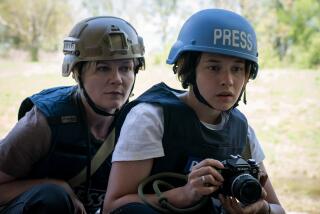Joseph Strick dies at 86; independent filmmaker brought âUlyssesâ to big screen
Joseph Strick, an independent filmmaker who brought James Joyceâs âUlyssesâ to the big screen and won an Academy Award for best documentary short subject for âInterviews with My Lai Veterans,â has died. He was 86.
Strick died of congestive heart failure Tuesday in a hospital in Paris, said his son, photographer David Strick.
FOR THE RECORD:
Joseph Strick: The obituary of filmmaker Joseph Strick in Fridayâs LATExtra section said he was survived by five grandchildren. There are six grandchildren. â
An Army Air Forces aerial photographer during World War II, Strick launched his filmmaking career after the war when he used an Army surplus movie camera to shoot âMuscle Beach,â a 1948 documentary short about Southern California bodybuilders.
After working on a number of other films, Strick recalled in an interview earlier this year with the Glasgow Herald Scotland, âI decided to leave the business to make some money so that I could make my own movies.â
Beginning in 1956, he was the key figure in a number of new science and technology companies, including Electrosolids Corp. and Physical Sciences Corp., which he would sell at a profit after getting them on their feet.
But even while becoming a successful business entrepreneur in the late `50s, he retained his filmmaking ambitions.
Teamed with Ben Maddow and Sidney Meyers, Strick and his colleagues spent four years making âThe Savage Eye,â a low-budget, 1960 film that incorporated documentary footage shot in gritty Los Angeles locations into the story of a young divorced woman attempting to start a new life.
The film won the British Academy of Film and Television Artsâ Robert J. Flaherty Award for best documentary.
âJoe was interested in looking at the underside of thingsâ on the film, recalled Oscar-winning cinematographer Haskell Wexler, who was a cinematographer on âThe Savage Eyeâ and on Strickâs 1971 documentary âInterviews with My Lai Veterans,â which featured American soldiers who were present at the My Lai massacre in Vietnam.
In looking at Strickâs films, Wexler said, âyou see that he is a maverick and was never a conventional filmmaker. You have to make your own judgment about the films that heâs made. I found them all very interesting and inventive content-wise, if not in style.â
Strick already had produced and directed a 1963 screen adaptation of Jean Genetâs play âThe Balconyâ when he tackled âUlysses,â Irish writer Joyceâs controversial and much-banned epic novel that is known for its stream-of-consciousness style and explicit language.
Strick directed and produced the modestly budgeted 1967 film on location in Dublin, and he and Fred Haines shared an Oscar nomination for their screenplay.
ââUlyssesâ is a remarkable achievement, a further chapter in the maturity of film,â Charles Champlin, The Timesâ movie critic, wrote in his review.
He noted, however, that âJoyceâs novel was harassed with censorship problems for years and Strickâs film has begun in the same travails.â
Indeed, the organizers of the Cannes film festival cut some of the movieâs French subtitles.
âHe hadnât been told this was going to happen,â David Strick said. âHe stood up and yelled out that this film had been censored. He went upstairs to the projection booth and turned off the switches. He was then pushed down a flight of stairs by festival goons, basically. My father and his associates withdrew the film immediately from the festival.â
In his interview earlier this year, Strick said that he âknew what kind of material I was choosing, but I was still surprised by the intensity of the reactions to the filmâŚ.In Ireland, the book had never been banned, but the film wasnât passed there until 2000!â
Among Strickâs other credits are a 1970 adaptation of the Henry Miller novel âTropic of Cancerâ (director, producer and co-writer), a 1977 adaptation of Joyceâs âA Portrait of the Artist as a Young Manâ (producer, director), and he was a producer of the 1983 movie âNever Cry Wolf.â
In the 1970s, Strick spent a number of years developing a motion-simulator-based theatrical experience in conjunction with a theatrical distribution company. It never went beyond the prototype stage, but he later worked as a technical consultant on the âStar Toursâ attraction at Disney theme parks.
Strick was born July 6, 1923, in Braddock, Pa., and later moved to Philadelphia. He attended UCLA before joining the Army during the war.
In the early 1960s, Strick commissioned legendary Brazilian architect Oscar Niemeyer to design a house for him and his first wife, Anne, on the edge of Santa Monica Canyon. But he and his wife separated before the house was completed, and he never lived in what is the only Niemeyer house in North America.
Strick primarily lived in Paris since the early 1970s.
In addition to his son David, he is survived by his wife, Martine; his other children, Jeremy (the former director of the Museum of Contemporary Art in Los Angeles who is now director of the Nasher Sculpture Center in Dallas), Betsy, Terence and Helene Strick-Marchand; his brother, Jack; his sister, Maida Gordon; and five grandchildren.
Services are pending.
More to Read
Start your day right
Sign up for Essential California for the L.A. Times biggest news, features and recommendations in your inbox six days a week.
You may occasionally receive promotional content from the Los Angeles Times.






